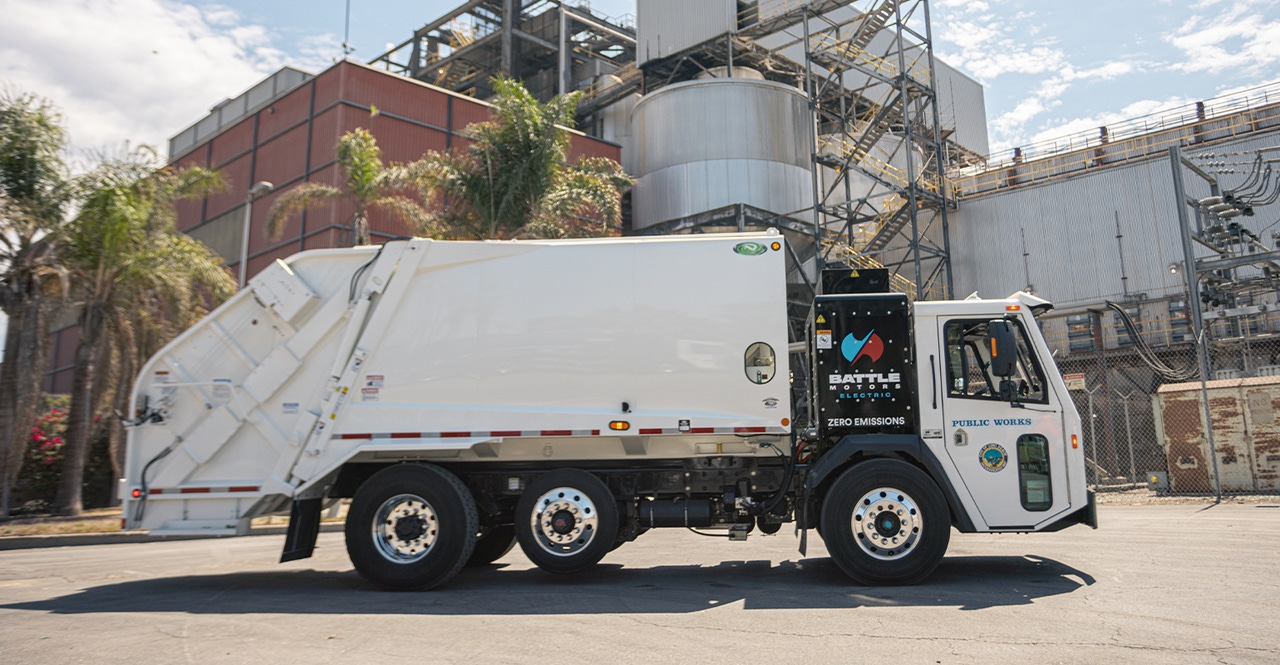Battle Motors Rolls Out Electric Trash Trucks
Battle Motors (formerly Crane Carrier) has been building trash trucks since the 1940’s, evolving its portfolio over time to include various diesel and compressed natural gas (CNG) vehicles, then expanding offerings to smart technology that enables two-way communication, routing functions, and reporting, among capabilities. Now the company is building electric trash trucks –rear and automated side loaders that are available in standard and crew cab configurations.

Battle Motors (formerly Crane Carrier) has been building trash trucks since the 1940’s, evolving its portfolio over time to include various diesel and compressed natural gas (CNG) vehicles, then expanding offerings to smart technology that enables two-way communication, routing functions, and reporting, among capabilities. Now the company is building electric trash trucks –rear and automated side loaders that are available in standard and crew cab configurations.
“We actually build electric vehicles for other vocational sectors, too, including the utility and construction segments. But our design starts with a focus on refuse trucks since that’s our heritage,” says Stan Mikalonis, chief revenue officer, Battle Motors.
So far, the New Philadelphia, OH-based company has sold about 50 of them in the waste management sector. Battle currently has trucks on order with what Mikalonis describes as some of the largest municipal and private refuse fleets in the country, with plans to expand through North America.
The company touts the EVs as being as reliable as the CNG- and diesel-powered trucks, but with lower maintenance costs, reduced noise, and zero-carbon emissions.
“Initial response from our customers is positive.
They want to try it. We have single axels already out there on the market. The larger ones are still with the body outfitters. Refuse body integration can be more complex with the larger vehicles,” Mikalonis says.
The big trucks with a gross vehicle weight (GVW) up to 72,000 come with a 396-kw battery pack, while the smaller models with a GVW of 26,000 or 33,000 come with a 240-kw battery pack.
Battle believes a roughly 72,000-GVW truck with the larger battery can run up to 8 to 10 hours a day on a normal collection route. The single-axel trucks with a 240-kw battery should run for the same length of time.
The truck manufacturer’s partner, PositivEnergy, provides EV charging and charging infrastructure at customer’ sites and works with utilities to ensure a grid connection and power availability on the receiving end.
“The idea is to make it as hands-off a process as possible for Battle Motors’ customers, while removing risks that can come with these types of installations.
“Charging solutions are available at point of sale. Customers just need to order the truck and infrastructure package,” says Vincent Benini, chief commercial officer, PositivEnergy.
These large vehicles are infrastructure-heavy assets. So preliminary work entails making sure pipes from the utility are large enough to support their needs. And that cables are also sufficiently sized. They may need to deliver as much energy as it would take to power 10 homes.
Ensuring the EV chargers are suited for industrial applications is a whole other consideration. Consumer retail-facing chargers aren’t sufficient, even falling short if they are upsized for big fleets, according to Benini.
So, the company builds them from the ground up for their intended application.
“We understand that if our equipment doesn’t work, garbage does not get picked up. Or an electric school bus does not get kids to school.
“So, we designed the equipment to be ruggedized and set up for intensive commercial use and, ultimately, reliability. This is an operational necessity,” Benini says.
The batteries should have a 10-year life span if trash trucks run roughly eight hours a day, though this is yet to be definitively determined, as they have not been in operation long enough to confirm.
It is not clear yet if the most severe applications can be electrified and meet hours of service requirements. Battle’s data suggest that these severe applications will not be able to replace diesel by one for one because, while the trucks are powerful, the batteries have limitations in more demanding uses.
“So, the question is, What trucks can you electrify to get close to a one-for-one replacement to diesel?
“The trend I see is that operators are going down in class from 8 to 7, 6, or 5, as you can electrify lower-class vehicles faster,” Mikalonis says.
Heavy-duty EV trucks won’t be predominant on collection routes in the immediate future. But as regulating authorities are required to provide their regions with necessary power, states are creating market mechanisms and incentives to support the transition to electrification of both cars and trucks. Such programs have been key to working toward speed to market, with the Inflation Reduction Act, just passed in August 2022, already bringing a further lift.
“We are seeing lot of interest and money made available to support adoption of EV charging infrastructure from this new legislation and a series of other federal bills. And that’s exciting,” Benini says, anticipating a further boon to the company’s business, which over the past decade has seen over 1,000 deployments of its EV truck charging technology through North America.
Battle too expects to see exponential growth, most recently gearing up to meet demand through acquisition of original equipment manufacturer Crane Carrier Company, and completion of a Series B investment round with $150 million in new growth capital (some of which will be dedicated to the EV line of business).
The refuse sector has an aggressive posture toward integrating EV into their fleets, more so than other vocational segments from what Mikalonis sees.
“The waste management industry is about clean and green. Their job is to clean up neighborhoods, picking up trash and recycling. Electric truck adoption aligns with their ESG goals and go-to market strategy.”
About the Author
You May Also Like




.png?width=300&auto=webp&quality=80&disable=upscale)